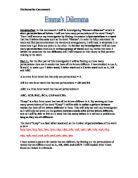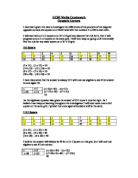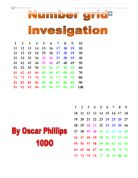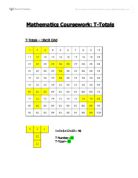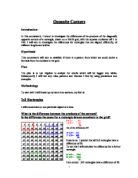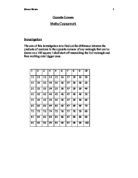Emma's Dilemma
Emmas Dilema Jonathan Busby This piece of coursewrk is to investigate the possible arrangements of Lucy and Emma. Also I have to investigate the number of different arrangements of various groups of letters. I will start my experiment off by investigating the two-lettered word JO. Two-Lettered Word JO OJ JO has a total of two letters making up its word. Therefore its total amount of arrangements is that of tom. Three-Lettered Word TOM, TMO, MOT, MTO, OMT, OTM I have a three lettered word (tom) which has a total of 6 different arangements, as i have shown above. Four-Lettered Word LUCY UCLY CYLU YCLU LUYC UCYL CYUL YCUL LYUC UYLC CULY YUCL LYCU UYCL CUYL YULC LCYU ULYC CLYU YLUC LCUY ULCY CLUY YLCU By arranging the letters in this way, I found that the four-lettered word LUCY had a total of 24 arrangements. By showing how many arrangements there were when the single letter L was at the beginning I could calculate the total amount of arrangements for the three remaining letters U, C And Y. If I then multiplied the number six (number of arrangements) by the number four (total amount of letters in the word) I could calculate the
Emma's Dilemma
Emma's Dilemma By Sophie Morand I'm going to investigate the number of ways the letters in the name Lucy can be arranged. I will do this systematically by finding all the different arrangements beginning with L, then beginning with U, then C, then Y. LUCY LUYC LCUY LCYU LYCU LYUC ULCY ULYC UCLY UCYL UYCL UYLC CLYU CLUY CUYL CULY CYUL CYLU YLCU YLUC YULC YUCL YCLU YCUL Including "Lucy" there are 24 arrangements of the letters L U C Y. I am going to use the same systematic method to investigate the arrangements of Emma. This name is different to the name Lucy as in Emma there is a double "m" and in Lucy no letters are repeated. EMMA EMAM EAMM MMAE MMEA MEAM MAEM MEMA MAME AMME AMEM AEMM Including "Emma" there are 12 ways of arranging E M M A. I am now going to investigate the number of ways a four-letter word with one letter repeated three times can be arranged. I will use the letters E M M M EMMM MEMM MMEM MMME There are four ways which the letters E M M M can be arranged, including "Emmm." A four-letter word with one letter repeated four times has only one way it can be arranged, for example MMMM has no other arrangements. I have organised my results in a table. From looking at the results in my table I can see a pattern When there are no letters repeated, like in Lucy, there are 24 arrangements. In a word with 2 letters repeated, such
Emma's dilemma.
Emma is playing with an arrangement of the letters in her name. * One arrangement is Emma * A different arrangement is Meam * Another arrangement is Aemm > Investigate the number of different arrangements for Emma's name. > Emma has a friend called Lucy. Investigate the number of different arrangements for Lucy's name. > Choose some different names and investigate the number of different arrangements for the names. A number of X's and Y's are written in a row such as: xxxx.......xx.....yyy....xyyyy > Investigate the number of different arrangements for the row of letters. ~*~*~*~*~*~*~*~*~*~*~*~*~*~*~*~*~*~*~*~*~*~ The number of different arrangements for Emma's name * EMMA MEAM MMEM MAEM * EMAM AEMM MMAE MEMA = 12 arrangements * EAMM AMEM MAME AMME The number of different arrangements for Lucy's name * LUCY LYCU UCYL CYLU CULY * LUYC LYUC UCLY CYUL CUYL * LCYU ULCY UYCL CLUY YLUC * LCUY ULYC UYLC CLYU YLCU * YUCL YULC YCLU YCUL = 24 arrangements For one letter there will obviously be only one combination E.g. B = one arrangement For two letters there will be two arrangements: E.g. * TI and IT = two arrangements For three letters there will six arrangements; E.g. * JON ONJ * JNO NJO * NOJ OJN Judging from the names investigated so far it is apparent that if a name with five letters is investigated it will have 120 different
Emma's Dilemma
Introduction Emma's Dilemma is about how many times a name or group of letters can be re-arranged. Firstly I will start by re-arranging the name 'Lucy.' I will state all the possible ways of re-arranging 'Lucy.' I will also find a formula for it. Secondly I will re-arrange the name 'Emma' and state the different re-arrangements. I will also find a formula for it. I will then use a different set of letters and names and find out how many times they can be re-arranged using a formula I create for it. Lastly, I will make my coursework harder by using words, which have more than one of the same letters, e.g. Mississippi. I will re-arrange AAB and then move on to more complicated ones like AABBCCDDEE. I will find a formula that relates to them as well. Hypothesis I think that the more letters there are, the more re-arrangements there would be whether there is more than one of the same letters. For e.g., when re-arranging a two-letter word, there will be two arrangements. Then, if I re-arrange a three-letter word there will be more re-arrangements due to the larger number of letters. > I will start by finding out how many times 'Lucy' can be re-arranged. Below are all the possibilities of re-arranging the name 'Lucy.' LUCY UCYL CYLU YLUC LUYC UCLY CYUL YLCU LYUC ULCY CLYU YULC LYCU ULYC CLUY YUCL LCUY UYCL CULY YCLU LCYU UYLC CUYL YCUL There are 24
Emma's Dillemma
. Emma 2 Emam 3 Eamm 4 Aemm 5 Amem 6 Amme 7 Meam 8 Mema 9 Mame 0 Maem 1 Mmae 2 Mmea There are 12 different arrangements of Emma 2. Lucy 2 Luyc 3 Lyuc 4 Lycu 5 Lcuy 6 Lcyu 7 Culy 8 Cuyl 9 Cylu 0 Cyul 1 Cluy 2 Clyu 3 Yclu 4 Ycul 5 Ylcu 6 Yluc 7 Yucl 8 Yulc 9 Ulcy 20 Ulyc 21 Uylc 22 Uycl 23 Uclu 24 Ucul There are 24 different arrangements of Lucy 3. Jo 2 Oj Joe 2 Jeo 3 Eoj 4 Ejo 5 Oje 6 Oej Ann 2 Nan 3 Nna JJ Number of Letters With Repeated Letters No Repeated Letters JJ Jo 2 2 Ann Joe 3 3 6 Emma Lucy 4 2 24 The "no repeated letters" field is equal to the "With repeated letters" field but doubled i.e Lucy = 4 letters = 24 arrangements all you need to do then is to divide it by 2 and you will have the value of "With repeated letters" field and visa versa. There is a quicker solution to this problem. All that you need to do is (If you need a 4 letter word) you would do 1x2x3x4. If you needed 5 letters you would do 1x2x3x4x5 and so on. If you want to find out the value of the repeated letters field you would then just divide it by 2. I predict that a 5 letter word will have 120 combinations because 1x2x3x4x5 = 120. 20 combinations will be too much so I will do a 5-letter word that has a repeated letter such as Barry Larry or Annie. This will, according to my theory
Emma's dillemma
Introduction: In this coursework I will be investigating "Emma's dilemma" which is about permutations of letters. I will see how many permutations of the word "Lucy". Then I will continue my investigation by finding the amount of permutations in a word that has 2 letters the same such as the word "Emma". In order to fully understand the work and find patterns between the words and arrangements, I will need to structure it to show how I got from one point to the other. To further my investigation I will see how many permutations there are in various groups of words such as, words that have 3 letters the same and the rest different, and I will expand on this theory to find patterns relating to the work. Part 1: For the first part of this investigation I will be finding out how many permutations there are in words that have all the letters different. I have decided to use A, B and C to make up a 1 letter word, 2 letter word and a 3 letter word such as A, AB and ABC. A is a one letter word that has only one permutation = A AB is a two letter word that has two permutations = AB and BA ABC is a three letter word that has six permutations = ABC, ACB, BAC, BCA, CAB and CBA. "Lucy" is a four letter word that has all the letters different in it. By working out how many permutations of the word "Lucy" I will be able to notice a pattern between words that have all the letters
emmas dilema
Emma's Dilemma Emma and Lucy are playing with arrangements of their names. One arrangement of Lucy is L U C Y A different arrangement is Y L C U Part 1 Investigate the number of different arrangements of the letters of Lucy's name. Part 2 Investigate the number of different arrangements of the letters of Emma's name. Part 3 Investigate the number of different arrangements of various groups of letters. Part 1 Set 1 Set 2 Set 3 Set 4 LUCY UCYL CUYL YCUL LUYC UCLY CULY YCLU LCUY ULCY CLUY YLUC LCYU ULYC CLYU YLCU LYCU UYCL CYUL YULC LYUC UYLC CYLU YUCL I have investigated the number of arrangements of the letters of Lucy's name in an organized way. I have written them out in sets with Set 1 beginning with L. Set 2 with U, Set 3 with C and Set 4 with Y. in each set the arrangements are written out in an order i.e. in set 1 the first 2 arrangements begin with LU, the 2 after that begin with LC and the 2 after that begin with LY. There are 24 different arrangements. Examples If it is just one letter then you cannot change it. If it is two letters like AB then it can be changed into AB or BA and there are 2 arrangements. If there are three letters like ABC then there are 6 arrangements. I organized this so that set 1 begins with A, set 2 with B and set 3 with C. Set 1 Set 2 Set 3 ABC BAC CAB ACB BCA CBA If there are four
Emmas dilemma
Investigation I am first going to write out all the combinations for the name Emma. emma eamm emam meam maem mmea mmae mema mame amme aemm amem This proves that if a name has the same arrangements of letters they will have the same total number of different combinations. However, this does not give me sufficient information to develop a formula. I am now going to look at names with 2 letters the same like Emma, but with a different total number of letters. I am going to look at all the combinations for the name Lucy. Lucy has 24 different combinations. This means that all names with 4 different letters will have a total of 24 different combinations. I am now going to look at different names with different numbers of letters. All the names I investigate will all have different letters. Name: Jo Total number of letters: 2 jo oj Jo has 2 different combinations. Name: Ian Total number of letters: 3 ian ina ani ain nai ain Ian has 6 different combinations. I have realised that the total number of combinations is the number of letters multiplied by the previous number of combinations. Name: Lucy Total number of letters: 4 Previous number of combinations: 6 Prediction: 4 x 6 = 24 lucy luyc lcyu lcuy lycu lyuc ulcy ulyc uylc uycl ucly ucyl cluy clyu culy cuyl cyul cylu yluc ylcu yclu ycul yucl yulc As i predicted
Investigate the relationship between the T-total and the T-number
T-Total and T-Number Coursework INTRODUCTION PART 1: INVESTIGATE THE RELATIONSHIP BETWEEN THE T-TOTAL AND THE T-NUMBER T-NUMBER T-TOTAL 20 37 21 42 22 47 23 52 24 57 The table above shows the difference between the consecutive T-Totals as the T-Number increases by one. On grid sheet 1, the T-Shapes can be seen being translated across the 9 x 9 grid by one square each time. There is a pattern between the T-Totals as the T-Shape is translated each time, as each time the T-Total increases by 5, as shown in the table above. Each T-Total on the diagrams increases by 5 each time it is translated one square across. This is because each square in the T-Shape increases by one each time it is translated, and as there are 5 squares in the T-Shape, a total increase of 5 is calculated for the T-Total. Already from this, I can begin to create a formula for working out the T-Total for any T-Shape on a 9 x 9 grid. n-19 n-18 n-17 n-9 n The formula shown in the T-Shape above should work out the T-Total for any T-Shape on a 9 x 9 grid. I now plan to test this theory, by taking a few random sample T-Numbers from the 9 x 9 grid and using the formula to work out the T-Total. I think that my formula is correct, and that it will give the correct T-Total each time, but I will check it anyway. 24 25 26 34 43 The T-Number of the T-Shape is 43. Using my formula, I can work
Investigate the relationship between the T-total and the T-number.
GCSE Math's Investigation Introduction In this investigation I'm going to investigate the relationship between the T-total and the T-number. What I'm going to do is use different sizes of grids for example 9*9, 8*8, 7*7, 6*6, 5*5 and 4*4. To compare the answers I will have to investigate each grid for a few times for example 9*9 grid will be investigated for at list three times. I will have to make predictions for each of the grids. I will also have to translate and compare different positions of the T-shape and the T-numbers. After I have finished the investigation I will then evaluate and compare the relationships between different sizes of grids. The first grid I will investigate will be the 9*9 grid. 2 3 4 5 6 7 8 9 0 1 2 3 4 5 6 7 8 9 20 21 22 23 24 25 26 27 28 29 30 31 32 33 34 35 36 37 38 39 40 41 42 43 44 45 46 47 48 49 50 51 52 53 54 55 56 57 58 59 60 61 62 63 64 65 66 67 68 69 70 71 72 73 74 75 76 77 78 79 80 81 2 3 1 20 T-number = 20 T-Total = 1+2+3+11+20=37 T20=37 n-19 n-18 n-17 n-9 n T-number = n T-Total = n+n-9+n-17+n-18+n-19 Tn = 5n-63 T-number = 20 Tn = 5n-63 20 * 5 = 100 -63 37 Here is another 9*9 grid I will use the similar method just like the one on the first page and see what I gate for this second one. The difference between these is that the







